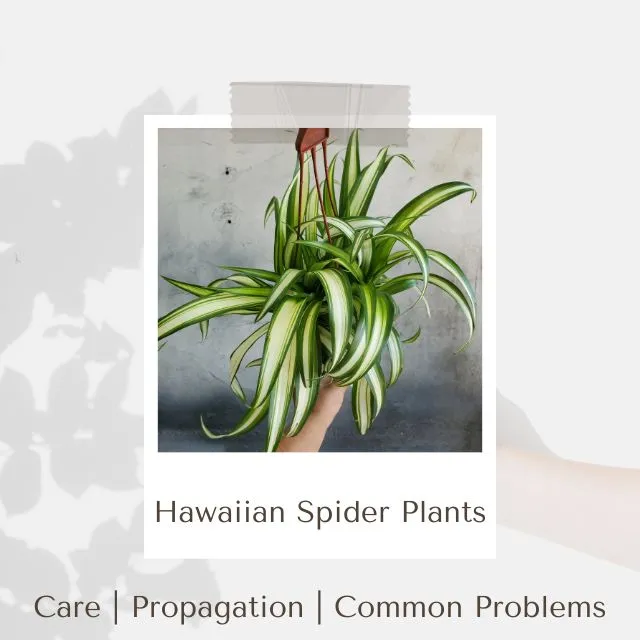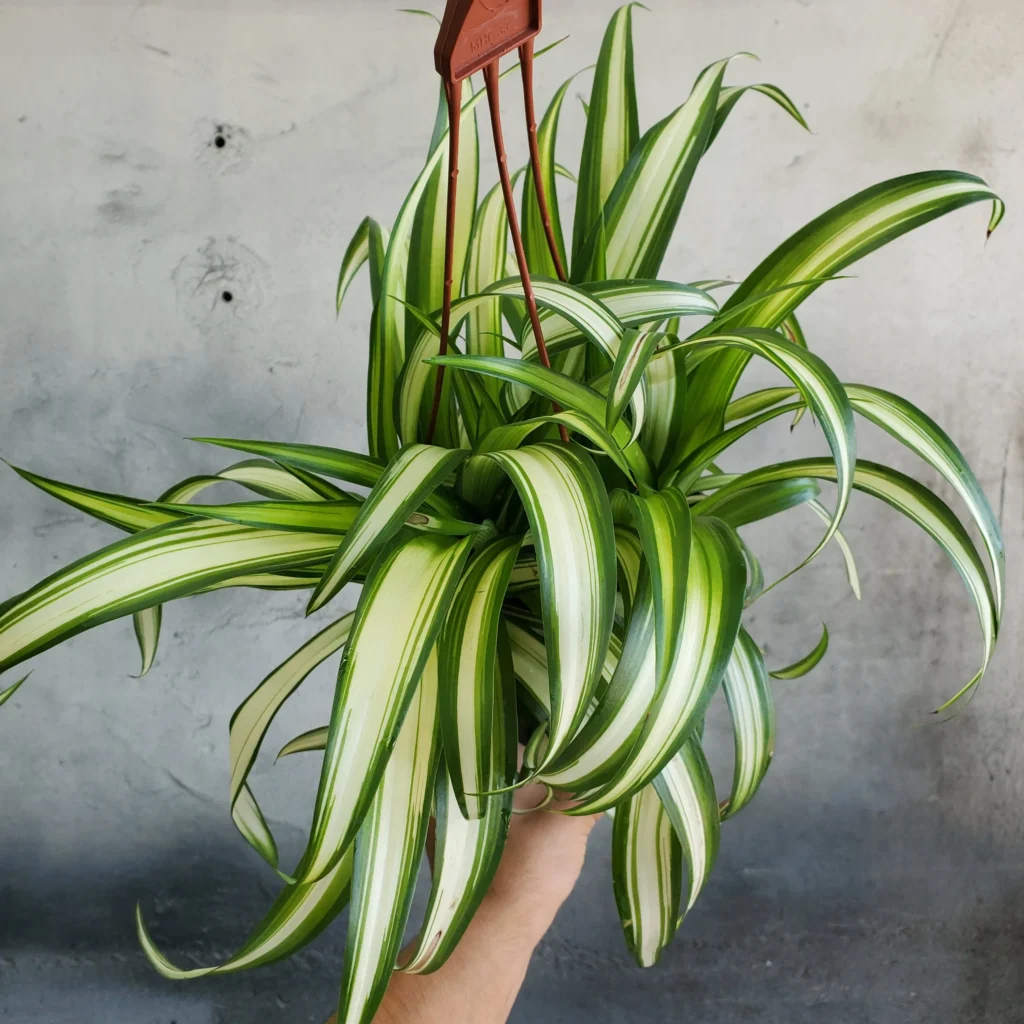The Hawaiian spider plant, also known as the Hawaiian spider lily or Hymenocallis festalis, is a tropical plant native to Central and South America. It is widely cultivated as an ornamental plant in many parts of the world for its attractive white flowers and unique foliage.
The plant is characterized by its long, strap-like green leaves that grow in a rosette pattern. The leaves can reach up to 2 feet in length and are typically about 1 inch wide. The plant produces tall, slender stalks that can reach up to 3 feet in height, topped with clusters of fragrant, funnel-shaped white flowers that bloom in the summer.
Hawaiian spider plants are relatively easy to grow and care for, making them popular among both novice and experienced gardeners. They prefer well-draining soil and partial to full sun exposure, and can be propagated by dividing the bulbs in the fall or early spring.
In addition to their ornamental value, Hawaiian spider plants are also believed to have medicinal properties and have been used in traditional medicine for centuries. The plant contains alkaloids that have antifungal, antibacterial, and anti-inflammatory properties. However, it should be noted that the plant is toxic if ingested, so care should be taken when handling it.

Characteristics of Hawaiian spider plant
Here are some of the characteristics of the Hawaiian spider plant:
- Foliage: The plant has long, strap-like green leaves that grow in a rosette pattern. The leaves can reach up to 2 feet in length and are typically about 1 inch wide. The leaves are glossy and slightly curved.
- Flowers: The Hawaiian spider plant produces tall, slender stalks that can reach up to 3 feet in height, topped with clusters of fragrant, funnel-shaped white flowers that bloom in the summer. The flowers are typically about 2 inches in diameter.
- Growth: The plant is a perennial and can grow up to 3 feet tall. It spreads slowly and can form clumps over time. It prefers well-draining soil and partial to full sun exposure.
- Propagation: The Hawaiian spider plant can be propagated by dividing the bulbs in the fall or early spring.
- Toxicity: The plant is toxic if ingested and can cause gastrointestinal discomfort, so care should be taken.
- Medicinal properties: The plant contains alkaloids that are said to have antifungal, antibacterial, and anti-inflammatory properties and have been used in traditional medicine for centuries.
- Ornamental value: The plant is widely cultivated as an ornamental plant in many parts of the world for its attractive white flowers and unique foliage. It is relatively easy to grow and care for, making it popular among novice and experienced gardeners.
Hawaiian Spider Plant Complete Care Guide
Here’s a complete care guide for the Hawaiian spider plant:
1. Light Requirements
The Hawaiian spider plant prefers bright, indirect light but can also tolerate some direct sunlight. Place the plant near a window with filtered sunlight or in a bright, well-lit room.
2. Water Requirements
Water the plant regularly, but be careful not to overwater it. Allow the top inch of soil to dry out between waterings, and ensure the soil is well-draining to prevent root rot. During the winter months, reduce watering to once every two weeks.
3. Temperature Requirements
The Hawaiian spider plant prefers warm temperatures, between 60-80°F (15-27°C). It can tolerate cooler temperatures but is sensitive to frost.
4. Humidity Requirements
The plant prefers high humidity levels but can tolerate average indoor humidity. Mist the leaves regularly with a spray bottle or place a humidifier near the plant to increase humidity levels.
5. Soil Requirements
Use a well-draining potting mix, such as a mix of peat moss, perlite, and vermiculite.
6. Fertilizer Requirements
Fertilize the plant every 2-3 weeks during the growing season (spring and summer) with a balanced fertilizer, diluted to half strength. Do not fertilize during the winter months.
7. Pruning Requirements
Remove any yellow or brown leaves, as well as spent flowers, to promote healthy growth and prevent disease. Prune the plant in the fall to keep it from getting too large.
Remember that the plant is toxic if ingested, so keep it away from children and pets.

Propagation of Hawaiian Spider Plant
Hawaiian spider plants can be propagated by dividing the bulbs between the fall and early spring. Here are the steps to propagate the plant:
- Carefully remove the plant from its pot and gently shake off any excess soil to expose the bulbs.
- Use a clean, sharp knife or scissors to cut the bulbs into smaller sections, ensuring each section has at least one healthy bulb and some roots attached.
- Dust the cut ends with a fungicide to prevent infection.
- Plant the divided bulbs in fresh, well-draining potting soil, making sure that the bulbs are planted at the same depth as they were before.
- Water the plant thoroughly and place it in a bright, indirect light. Avoid direct sunlight until the plant has had a chance to recover.
- Keep the soil evenly moist but not waterlogged, and avoid fertilizing for the first few weeks.
- After a few weeks, new growth should appear, indicating that the plant has successfully propagated.
Propagation can also be done by collecting and planting the seeds produced by the plant’s flowers. However, this method is less common and may only sometimes be successful.
Also Check: Complete String of Hearts Plant Care & Varieties Guide
Common Problems & Solutions
Here are some common problems that you may encounter when caring for a Hawaiian spider plant, along with their solutions:
1. Yellow or Brown Leaves:
Problem: This can be caused by overwatering, underwatering, or exposure to direct sunlight.
Solution: To fix this, adjust your watering schedule and ensure the plant is getting the right amount of light.
2. Root Rot:
Problem: Root rot is caused by overwatering and can cause the roots to turn brown and mushy.
Solution: To fix this, allow the soil to dry out before watering and ensure the plant is not sitting in water.
3. Pests:
Problem: Spider mites, mealybugs, and scale insects can infest the plant and cause damage to the leaves.
Solution: Treat the plant with insecticidal soap or neem oil to fix this.
4. Stunted Growth:
Problem: Stunted growth can be caused by poor soil quality or lack of nutrients.
Solution: To fix this, fertilize the plant with a balanced fertilizer and ensure it is planted in well-draining soil.
5. Fungal Infections:
Problem: Fungal infections can cause the plant to develop black spots or powdery mildew.
Solution: Remove any infected leaves and treat the plant with a fungicide to fix this.
6. Brown Tips:
Problem: Brown tips can be caused by low humidity or exposure to dry air.
Solution: To fix this, mist the leaves regularly or place a humidifier near the plant.
7. Toxicity:
Problem: It is important to note that the Hawaiian spider plant is toxic to cats, dogs, and other pets if ingested. The plant contains saponins, which can cause vomiting, diarrhea, and other gastrointestinal symptoms if eaten in large quantities.
Solution: If you have pets in your home, it is important to keep the Hawaiian spider plant out of reach or choose a different plant that is non-toxic. If you suspect that your pet has ingested any part of the plant, contact your veterinarian immediately.
Overall, the key to keeping your Hawaiian spider plant healthy is to provide it with the right amount of water, light, and nutrients. Regular monitoring and proper care will help to prevent problems before they occur.
Conclusion:
In conclusion, the Hawaiian spider plant is a beautiful and easy-to-care-for houseplant that can bring a touch of tropical elegance to any home. With its attractive foliage and air-purifying properties, it is a popular choice for novice and experienced plant owners.
To care for your Hawaiian spider plant, provide it with bright, indirect light, well-draining soil, and regular watering. Fertilize it during the growing season, prune it as needed, and propagate it by dividing the bulbs between the fall and early spring.
Watch out for common problems like yellow or brown leaves, root rot, pests, and fungal infections, and take steps to address them promptly.
With proper care and attention, your Hawaiian spider plant will thrive and add a beautiful touch of greenery to your indoor space.
Also Check: Best Alocasia Lauterbachiana Care Guide | Propagation
Frequently Asked Questions about Hawaiian Spider Plants
Are Hawaiian spider plants easy to care for?
Yes, Hawaiian spider plants are generally easy to care for as long as they are given the right conditions, including bright, indirect light, well-draining soil, and regular watering.
Can Hawaiian spider plants grow in low light?
While Hawaiian spider plants prefer bright, indirect light, they can also tolerate lower light conditions. However, in low light, the plant may grow more slowly and produce fewer flowers.
How often should I water my Hawaiian spider plant?
Hawaiian spider plants should be watered when the top inch of soil feels dry to the touch. Avoid overwatering, as this can lead to root rot and other problems.
How often should I fertilize my Hawaiian spider plant?
Hawaiian spider plants can be fertilized once a month during the growing season (spring and summer) with a balanced fertilizer.
Can Hawaiian spider plants be grown outdoors?
Hawaiian spider plants can be grown outdoors in warm, humid climates with partial shade. However, they are typically grown as indoor houseplants in cooler climates.
How can I propagate my Hawaiian spider plant?
Hawaiian spider plants can be propagated by dividing the bulbs in the fall or early spring. Alternatively, they can be propagated by collecting and planting the seeds produced by the plant’s flowers.
Are Hawaiian spider plants toxic to pets?
Yes, Hawaiian spider plants are toxic to cats, dogs, and other pets if ingested. Keep the plant out of reach of pets, or choose a different plant that is non-toxic.
